Hassani S. Mathematical Physics: A Modern Introduction to Its Foundations
Подождите немного. Документ загружается.

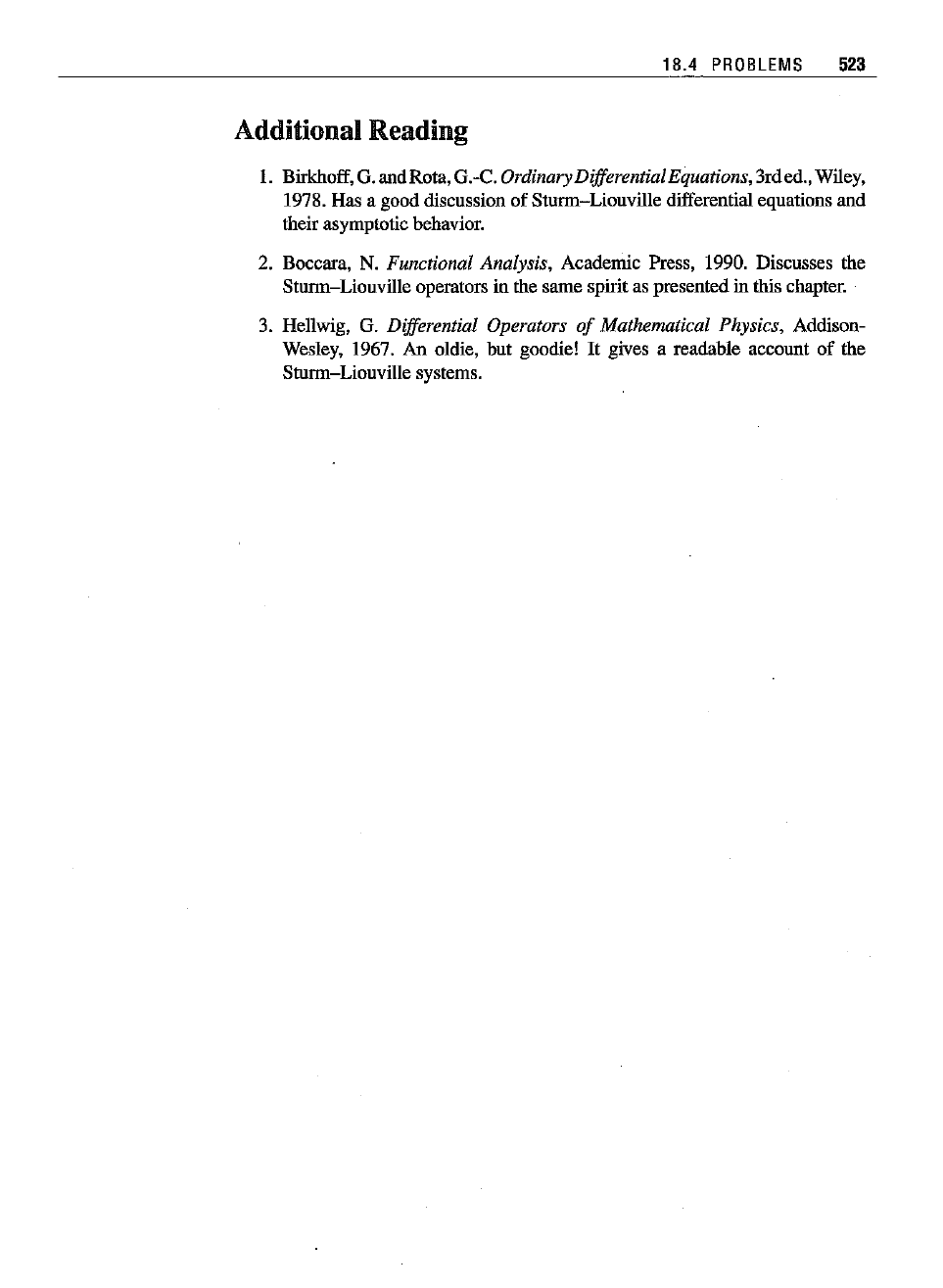
IB.4
PROBLEMS
523
Additional Reading
1. Birkhoff, G. andRota, G.-C. OrdinaryDifferentialEquations, 3rded.,Wiley,
1978. Has a good discussion of Sturm-Liouville differential equations and
their asymptotic behavior.
2. Boccara, N.
Functional Analysis, Academic Press, 1990. Discusses the
Sturm-Liouville operators in the same spirit as presented
in this chapter.
3. Hellwig, G.
Differential Operators
of
Mathematical Physics, Addison-
Wesley, 1967.
An oldie, but goodie!
It
gives a readable account of the
Sturm-Liouville systems.
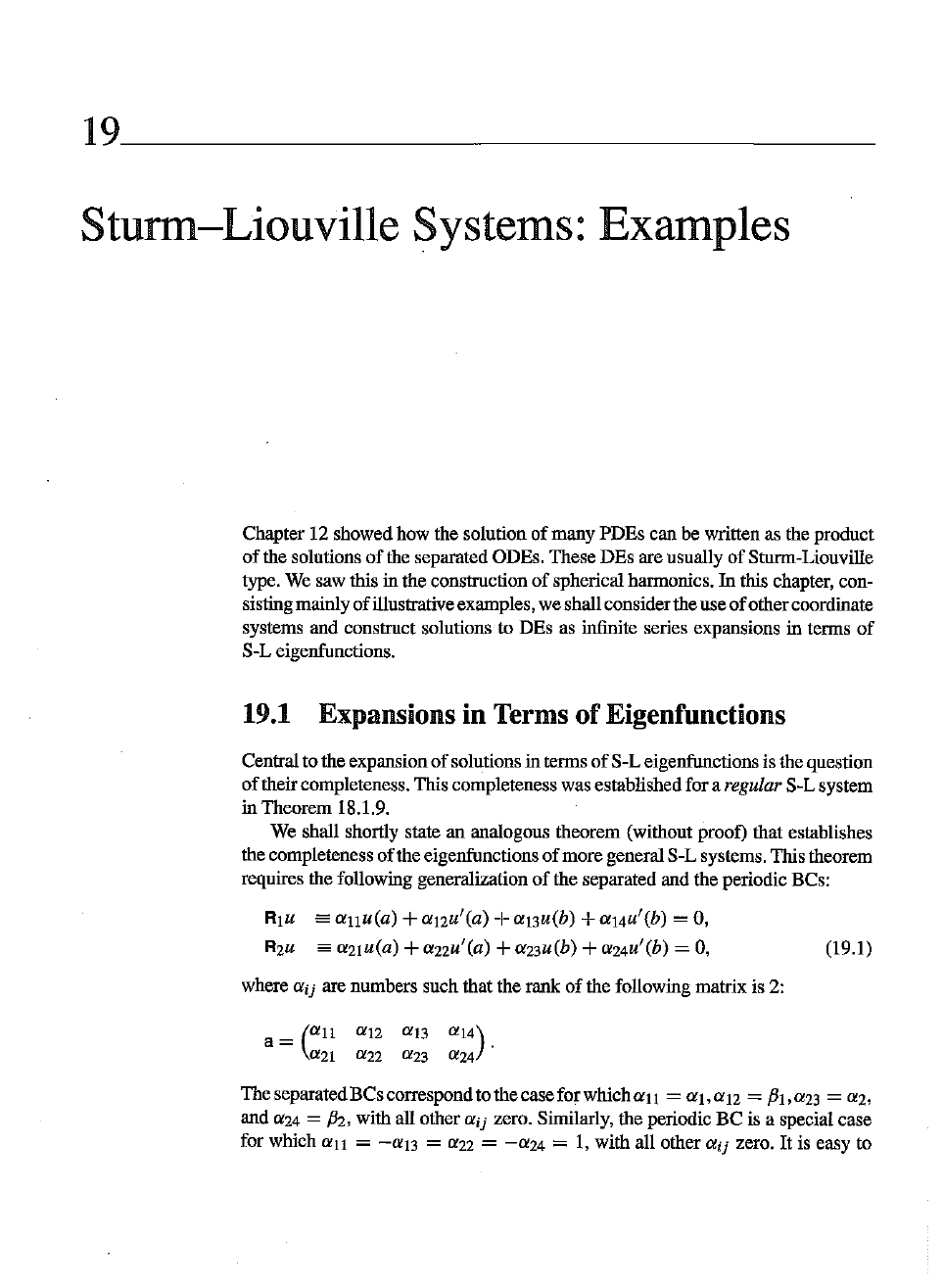
19 _
Sturm-Liouville Systems: Examples
Chapter 12 showed how the solution of many PDEs can be written as the product
of the solutions of the separated ODEs. These DEs are nsually of Sturm-Liouville
type. We saw this in the construction of spherical harmonics.
In
this chapter, con-
sistingmainlyof illustrative examples,we shallconsiderthe use ofothercoordinate
systems and construct solutions to DEs as
infinite
series expansions in terms
of
SoLeigenfunctions.
19.1 Expansions in Terms
of
Eigenfunctions
Central to the expansionof solutions in terms
of
SoLeigenfunctions is the question
of their completeness. This completeness was establishedfor a
regular SoLsystem
in Theorem 18.1.9.
We shall shortly state an analogous theorem (without proof) that establishes
the completeness of the eigenfunctions of moregeneral SoLsystems. This theorem
requires the following generalization of the separated and the periodic BCs:
RIU
==
anura)
+a12u'(a) +
anu(b)
+
aI4u'(b)
= 0,
Rzu sa
aZlu(a)
+
«nu'ta)
+aZ3u(b) +a24u'(b) = 0,
where
aij
are numbers such that the rank of the following matrix is 2:
(19.1)
TheseparatedBCscorrespondtothecaseforwhichan
=
aj,
a12 = fh,az3 =az,
and
aZ4
= th, with all other
aij
zero. Similarly, the periodic BC is a special case
for which
an
=
-an
= azz =
-a24
= I, with all other
aij
zero.
It
is easy to
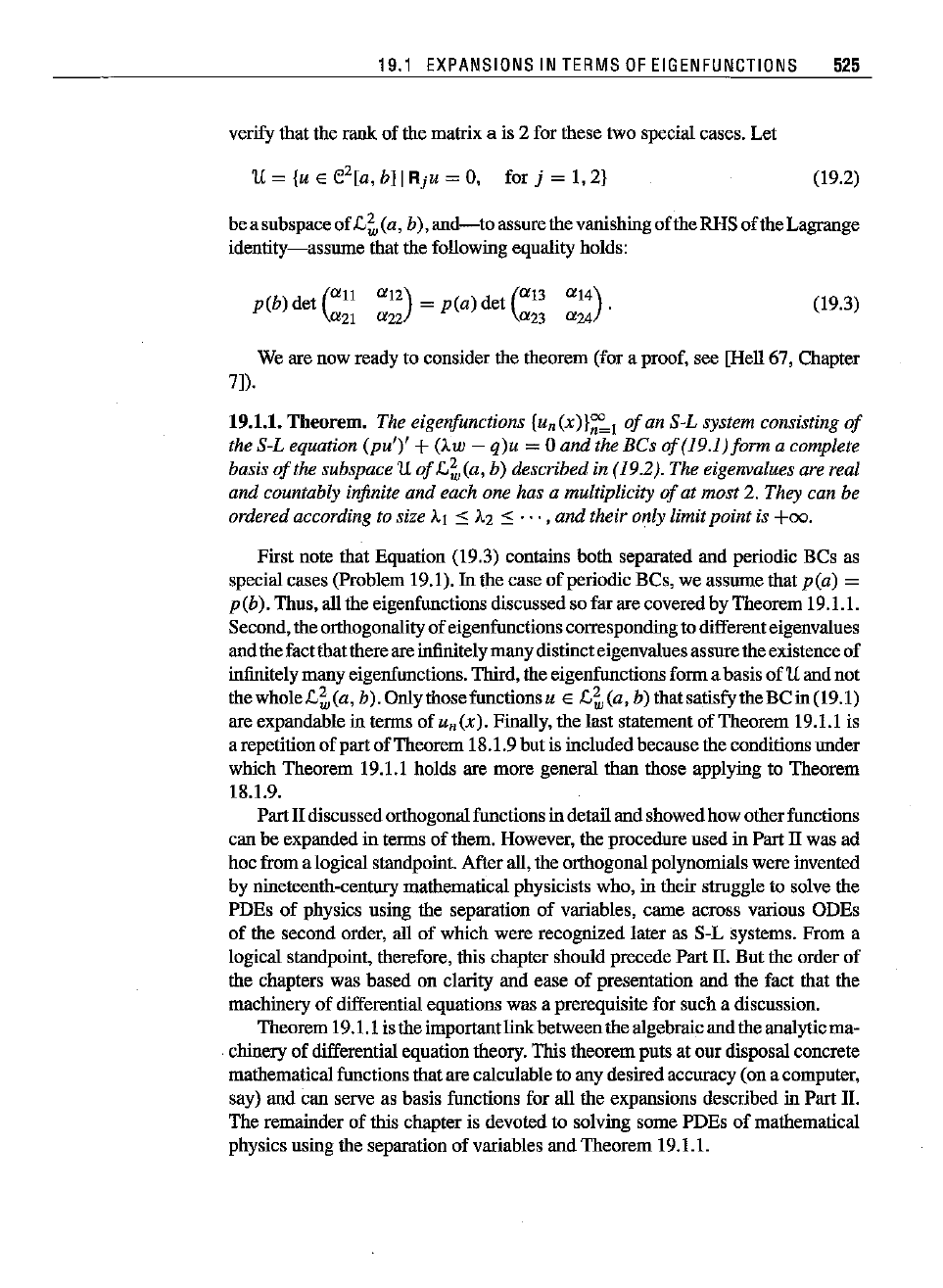
19.1
EXPANSIONS
IN
TERMS
OF
EIGENFUNCTIONS
525
verify that the rank of the matrix a is 2 for these two special cases. Let
ll=
{u E
eZ[a,bJIRju
=0,
for j = 1,2} (19.2)
bea
subspace
of.c~
(a, b),
and-to
assure the vanishing
oftheRHS
ofthe Lagrange
identity-assume
that the following equality holds:
(b) det
("'U
"'12)
= (a) det
("'t3
"'t4).
P "'ZI "'22 P "'Z3 "'24
(19.3)
We are now ready to consider the theorem (for a proof, see [Hell 67, Chapter
7]).
19.1.1.
Theorem.
The eigenfunctions
(un(x)}~1
of
an S-L system consisting
of
the S-L equation (pu')' +(Aw - q)u = 0 and the
Bes
of(19.1)form a complete
basis
of
the subspace II
of
.c~(a,
b) described in (19.2). The eigenvalues are real
and countably infinite and each one has a multiplicity
of
at most 2. They can be
orderedaccording to size
Al :::
Az
:::
..
" and their only limit point is
+00.
First note that Equation (19.3) contains both separated and periodic BCs as
special cases (problem 19.1).10the case
of
periodic BCs, we assume that pea) =
p (b). Thus, all the eigenfunctions discussed so far are covered by Theorem 19.1.1.
Second,the orthogonality
of
eigenfunctionscorrespondingto differenteigenvalues
andthe fact that there areinfinitely many distincteigenvaluesassure the existence of
infinitely many eigenfunctions.Third, the eigenfunctions form a basis of II and not
thewhole.c~(a,
b). Onlythosefunctionsu E
.c~(a,
b) thatsatisfytheBCin(19.1)
are expandable in terms of
u,,(x). Finally, the last statement of Theorem 19.1.1 is
a repetition of part of Theorem 18.1.9 but is includedbecause the conditiuns under
which Theorem 19.1.1 holds are more general than those applying to Theorem
18.1.9.
Part IIdiscussedorthogonalfunctions in detailand showed how otherfunctions
can be expanded in terms of them. However, the procedure nsed in Part II was ad
hoc from a logical standpoint. After all, the orthogonalpolynomials were invented
by nineteenth-century mathematical physicists who, in their struggle to solve the
PDEs
of
physics using the separation of variables, carne across various ODEs
of
the second order, all of which were recognized later as S-L systems. From a
logical standpoint, therefore, this chapter shonld precede Part II.
But
the order of
the chapters was based on clarity and ease of presentation and the fact that the
machinery
of
differential equations was a prerequisite for such a discussion.
Theorem 19.1.1is the importantlink betweenthe algebraic and the analytic ma-
chinery of differential equationtheory. This theorem puts at our disposal concrete
mathematical functions that are calculableto any desired accuracy (on a computer,
say) and can serve as basis functions for all the expansions described in Part II.
The remainder of this chapter is devoted to solving some PDEs
of
mathematical
physics using the separation of variables and Theorem 19.1.1.

526 19. STURM-LIOUVILLE SYSTEMS:
EXAMPLES
x
c
b
t:P=
f(x,y)
y
Figure 19.1 A rectangular conducting box of which one face is held at the potential
f (x,
y)
and the otherfaces aregrounded.
19.2 Separation in Cartesian Coordinates
(19.4)
d
2Z
-2
+vZ=O,
dz
Problems
most
suitablefor Cartesiancoordinates have boundaries withrectangular
symmetry such as boxes or planes.
19.2.1.
Example.
RECrANGULAR CONDUCTING BOX
Considera rectangularconducting
box
with sidesa, b,
and
c (see
Figure
19.1). All faces are
held
at zero potential except the top face,
whose
potential is given by a function
f(x,
y).
Let us find the potential at all points inside
the
box.
The
relevant
PDEfor
this situationis
Laplace's
equation, V
2
ep
= O.Writing
cJl(x,
y, z)
as a product of three functions,
<I>(x,
y, z) =
X(x)Y(y)Z(z),
yields three ODEs (see
Problem19.2):
d
2X
-2
+AX=O,
dx
rectangular
conducling
box
where A+
f.l-
+v = O.
The
vanishing
of
cI>
at x = 0
and
x = a
means
that
forn=
1,2,
....
<1>(0,
y, z) =
X(O)Y(y)Z(z)
= 0 V y, z
=}
X(O) = 0,
<I>
(a, y, z) =
X(a)Y(y)Z(z)
= 0 Vy, z
=}
X(a)
=
O.
Wethus obtain an S-L system, XIf +AX = 0, X(O) = 0 =
X(a),
whose
Be
is neither
separated
nor
periodic,
but
satisfies (19.1)
with
au
=
Q(23
= 1
and
all
other
aii zero. This
S~L
systemhas the eigenvalues
and
eigenfunctions
An
=
(n;)2
and XIl(X) = sin
(n;x)
Similarly, the second equation in (19.4) leads to
(
mn)2
JLm= b
and for m =
1,2,
....
On the
other
hand, the third
equation
in (19.4) does
not
lead
to an S-L system
because
the Befor the top
of
the
box
does
not
fit (19.1).
This
is as expectedbecausethe "eigenvalue"
v is already determined by Aand
JL.
Nevertheless, we
can
find a solution for
that
equation.
The
substitution
2 _
(,!!:)2
(mn)2
Y
mn
- a
+ b
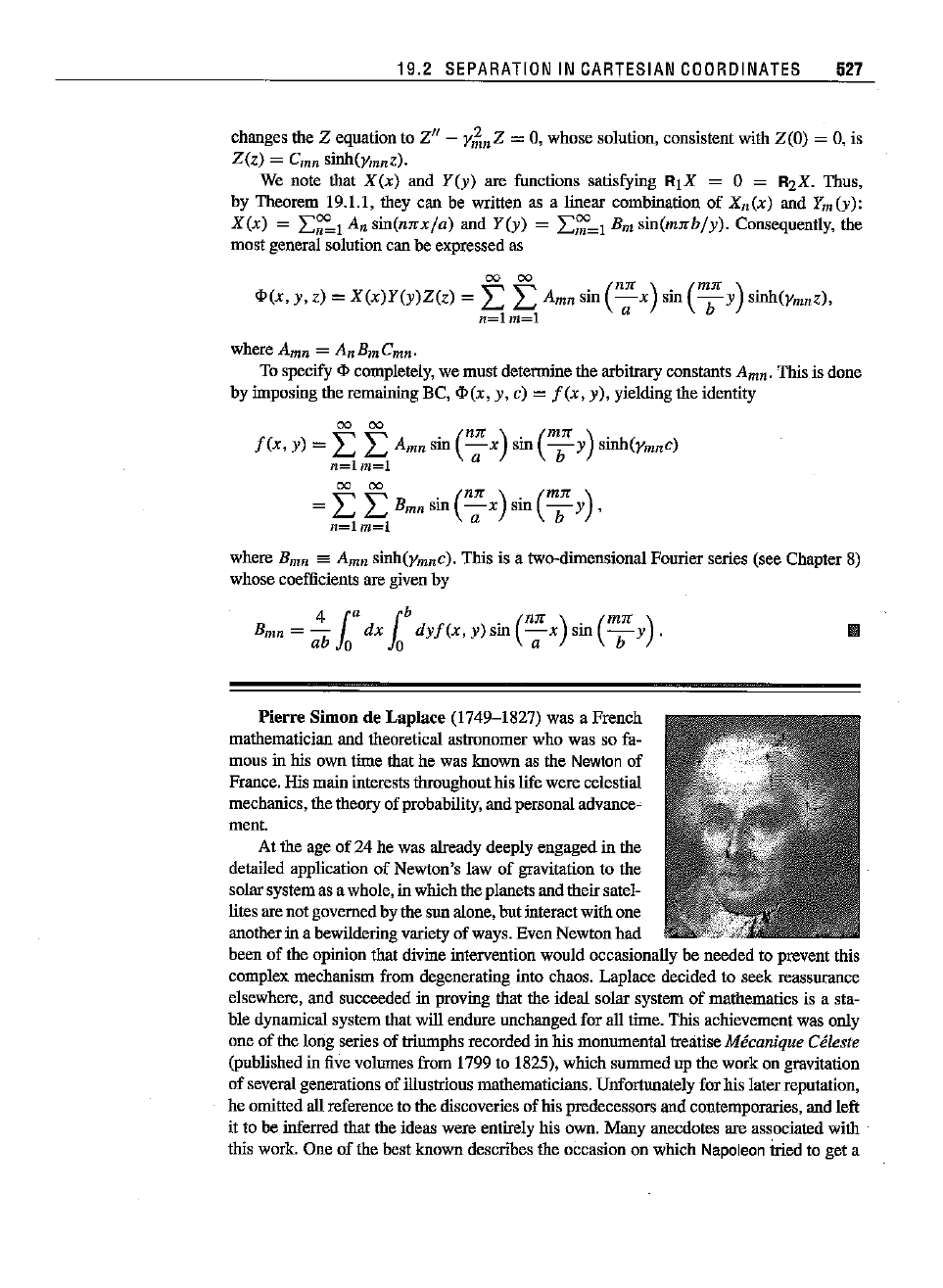
19.2
SEPARATION
IN
CARTESIAN
COORDINATES
527
changes the Z equation to
Z"
-
Y~n
Z = 0, whose solution, consistent with Z (0) = 0, is
Z(z)
= Cmn sinh(Ymnz).
We note that
X(x)
and
Y(y)
are functions satisfying
RIX
= 0 = R2X. Thns,
by Theorem 19.1.1, they
can
be written as a linear combination
of
Xn(x)
and
YmCy):
X(x)
=
I:~l
An
sin(mrxja)
and
Y(y)
=
I:;;,'=l
B
m
sin(mrrbjy).
Conseqnently, the
most general solution can be expressed as
00
00
<I>
(x,
y, z) =
X(x)Y(y)Z(z)
= L L A
mn
sin
c:
x)
sin
(mbrr
y)
sinh(YmnZ),
n=lm=l
where A
mn
=
AnBmC
mn.
To specify
cI>
completely, we
must
determine the arbitrary constants A
mn
.
This is done
by imposing the remaining BC,
<I>
(x,
y, c) =
f(x,
y),
yielding the identity
00 00
f(x,
y) = L L A
mn
sin
c:
x)
sin C
rr
y)
sinh(Ymn
c)
n=lm=!
= f f
BmnsinC
x)
sin C
rr
y),
n=lm=!
where Bmn
==
A
mn
sinh(Ymnc). This is a two-dimensional Fourier series (see Chapter 8)
whose coefficients are given by
4
fa t'
(nrr)
(mrr)
B
mn
= ab
10
dx
1
0
dyf(x,
y)sin
--;;x
sin
bY
.
III
Pierre
Simon
de
Laplace
(1749-1827) was a French
mathematician and theoretical astronomer who was so fa-
mous
in his own time that he was known as the Newton
of
France. His main interests throughouthis life were celestial
mechanics, the theory of probability, and personal advance-
ment.
At the age
of
24 he was already deeply engaged in the
detailed application
of
Newton's law
of
gravitation to the
solarsystemas a whole,in whichthe planetsand theirsatel-
lites are not governedby the sun alone, but interact
with
one
anotherin a bewildering variety
of
ways. EvenNewton
had
been
of
the opinion that divine intervention would occasionally be needed to prevent this
complex mechanism from degenerating into chaos. Laplace decided to seek reassurance
elsewhere, and succeeded in proving that the ideal solar system
of
mathematics is a sta-
ble dynamical system that will endure unchanged for
all time. This achievement was only
one
of
the long series
of
triumphs recorded in his monumental treatise Mecamque Celeste
(published in five volumes from 1799 to 1825), which summedup the
work
on gravitation
of
several generations of illustrious mathematicians. Unfortunately for his later reputation,
he omitted
all reference to the discoveries of his predecessors and contemporaries, and left
it to be inferred that the ideas were entirely his own.
Many
anecdotes are associated with
this work. One
of
the best known describes the occasion on which
Napoleon
tried to get a
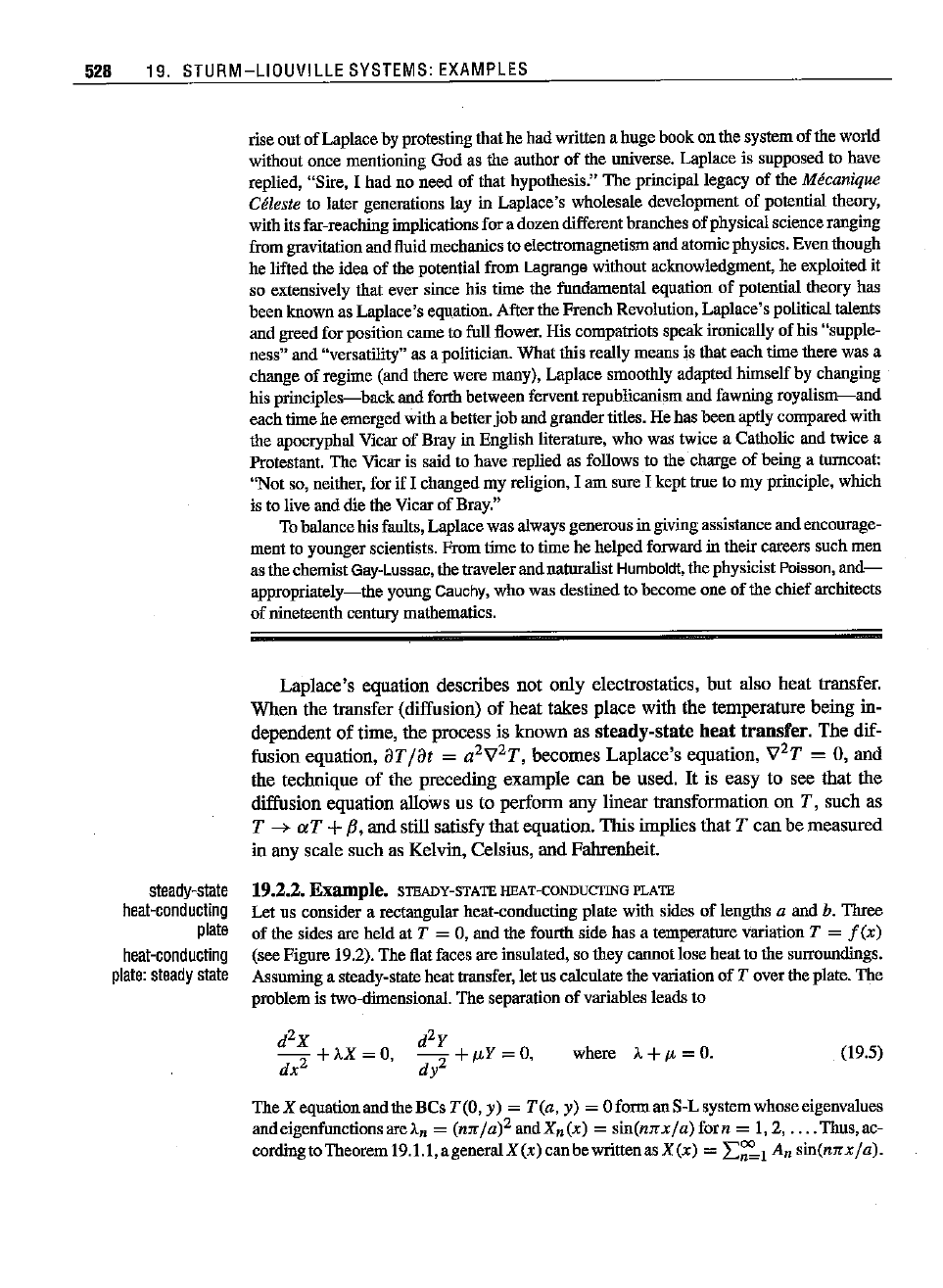
528 19. STURM-LIOUVILLE
SYSTEMS:
EXAMPLES
riseoutofLaplaceby protestingthathehadwrittenahugebookonthesystemoftheworld
without once mentioning God as the author
of
the universe. Laplace is supposed to have
replied, "Sire, I had no need
of
that hypothesis." The principal legacy
of
the Mecanique
Celeste
to later generations lay in Laplace's wholesale development of potential theory,
withitsfar-reachingimplicationsfor adozendifferentbranchesofphysical scienceranging
fromgravitationandfluidmechanics
to electromagnetismandatomicphysics.Eventhough
helifted the idea
of
the potential from Lagrange without acknowledgment, he exploited it
so extensively that ever since his time the fundamental equation
of
potential theory has
been known as Laplace's equation. Afterthe French Revolution, Laplace's political talents
and greed for position came to full flower. His compatriots speakironically of his "supple-
ness" and "versatility" as a politician. What this really means is that each time there was a
changeof regime (andthere were many),Laplacesmoothlyadaptedhimselfby changing
his
principles-back
and forth between fervent republicanism and fawning
royalism-and
eachtime he emergedwith a better
job
and grander titles. He has
been
aptly compared with
the apocryphal Vicar
of
Bray in English literature, who was twice a Catholic and twice a
Protestant. The Vicar is said to have replied as follows to the charge
of
being a turncoat:
"Not so, neither, for if I changed my religion, I am sure I kept true to my principle, which
is to live and die the Vicar
of
Bray."
Tobalancehis faults, Laplace was always generousin giving assistance and encourage-
mentto younger scientists. From time to time he helped forward in their careers such men
as the chemist
GaywLussac.the travelerand naturalist Humboldt,the physicist Poisson,
and-
appropriately-the
young Cauchy, who was destined to become one
of
the chiefarchitects
of
nineteenth century mathematics.
Laplace's equation describes not only electrostatics, but also heat transfer.
When the transfer (diffusion)
of
heat takes place with the temperature being in-
dependent
of
time, the process is known as
steady-state
heat
transfer.
The dif-
fusion equation,
aT fat = a
2
V
2
T , becomes Laplace's equation, V
2T
= 0, and
the technique
of
the preceding example can be used.
It
is easy to see that the
diffusion equation allows us to perform any linear transformation on
T, such as
T
->
«T
+
P,
and still satisfy thatequation. This implies that T
can
be measured
in any scale such as Kelvin, Celsius, and Fahrenheit.
steady-state
haat-conducting
plate
haat-conducting
plata:
steady
state
19.2.2.
Example.
STEADY-STATE HEAT-CONDUCTING PLATE
Let
us consider a rectangular heat-conducting plate with sides
of
lengths a and b. Three
of the sidesare heldat T = 0, and the fourthside has a temperaturevariationT = f
(x)
(see Figure 19.2). The flat faces are insulated. so they cannotlose heat to the surroundings.
Assuming a steady-state heat transfer, let us calculate the variation
of
T over the plate. The
problem is two-dimensional. The separation
of
variables leads to
where A+ f.' =
O.
(19.5)
TheXequationandtheBCsT(O, y) =
I'(a,
y) = oformanS-Lsystemwhoseeigenvalues
and eigenfunctions are An =
(mr/ap
and X
n
(x) =
sin(mrx/a)
forn
=
1,2,
....
Thus.ac-
cordingtoTheorem19.1.1,ageneralX(x)canbewrittenasX(x) =
L:~t
An
sin(nrrxja).
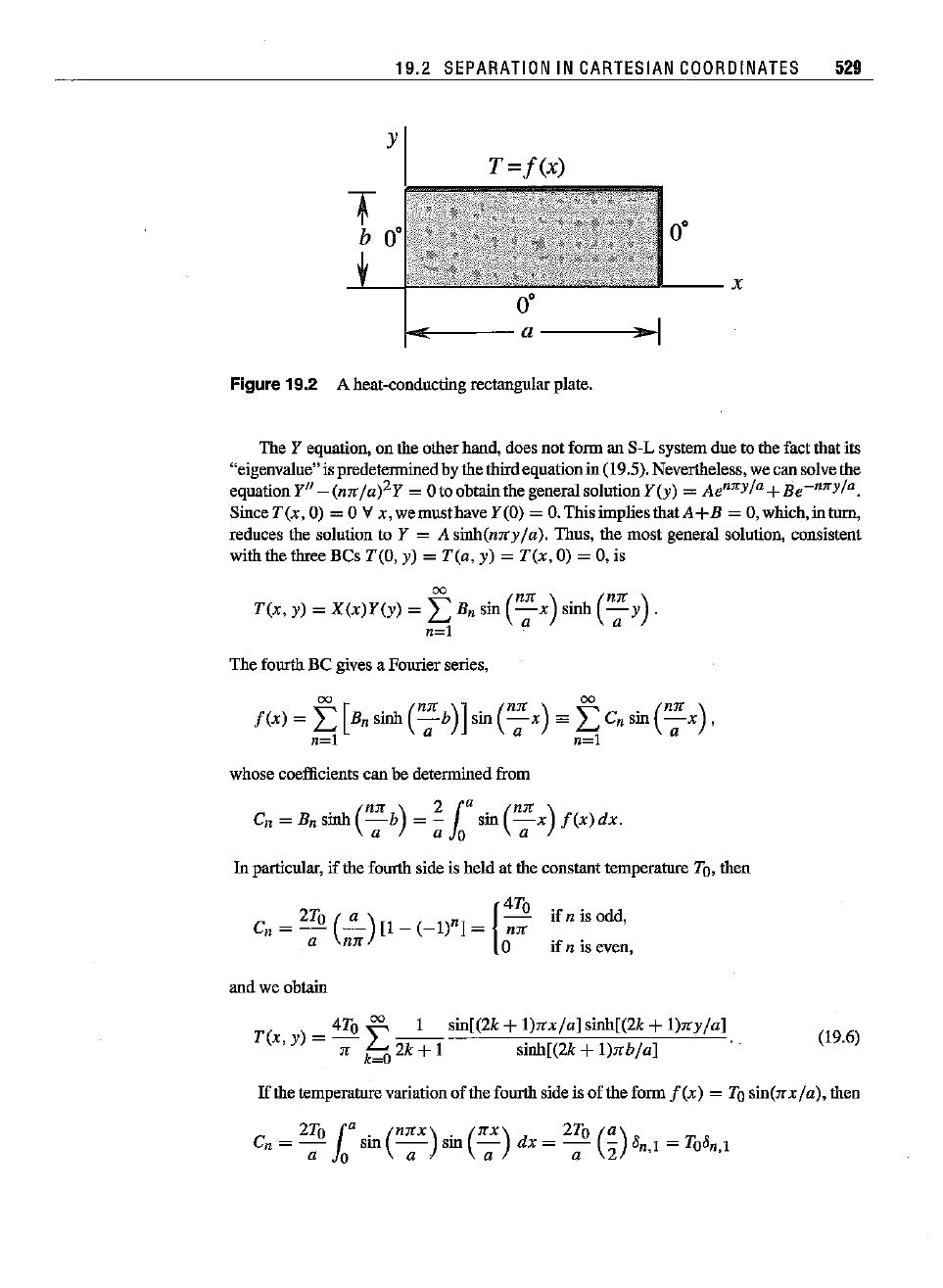
19.2
SEPARATION
IN
CARTESIAN
COOROINATES
529
T=f(x)
o·
---x
301
o·
f-oE----
a
------;~
Figure 19.2 A heat-conducting rectangular plate.
TheY
equation,
onthe
other
hand,
doesnotformanS-Lsystemduetothefact
that
its
"eigenvalue"
is
predetermined
bythe
third
equation
in(19.5).Nevertheless, wecansolvethe
equation
Y"
-(mr/apr
= Otoobtainthe
general
solutionY(y) = Aen:Jry/a +
Be-
mr
y/
a
.
Since T'[x, 0) =0
'I
x, wemust have Y(O) =
O.
This implies
thatA+B
= 0, which.tnturn,
reduces
thesolution to Y = A sinh(mryja).
Thus,
themost
general
solution,
consistent
with the three
Bes
T(O, y) =
T(a,
y) =
T(x,
0) = 0, is
00
ri»,
y) = X(x)Y(y) = L
s;
sin
err
x)
sinh
err
y).
n=l
a a
The
fourth
Be
givesa
Fourier
series,
~
[ .
(nrr)].
(nrr)
~
.
(nrr
)
f(x)
=
L-
s;smh
--;;b
sm --;;x sa
L-
en sin --;;x ,
11=1
n=l
whose coefficientscanbe
determined
from
(
nrr )
2 fa
(nrr)
c, =s; sinh --;;b =;;
10
sin --;;x
f(x)
dx.
In
particular,
if the
fourth
sideis heldatthe
constant
temperature
To.
then
2T. {
4
TO
c; =
--.!l.
(.!'-)
[1-
(_1)n] =
nrr
a nH 0
if n is odd,
if
n is even,
and we obtain
T(x,
y) = 4To f 1 sin[(2k + 1)rrx/alsinh[(2k +
I)rry/al.
n
k~O
2k +I sinh[(2k +I)rrb/a]
(19.6)
If
the
temperature
variation
of the
fourth
sideis of the
form
f (x) = Tosin(n
x/a).
then
2To Ina
(nrrx)
(rrx)
2To
(a)
en = - sin
--
sin - dx = - - 8
n
1 =
To8
n
1
a 0
a-
a a
2'
,
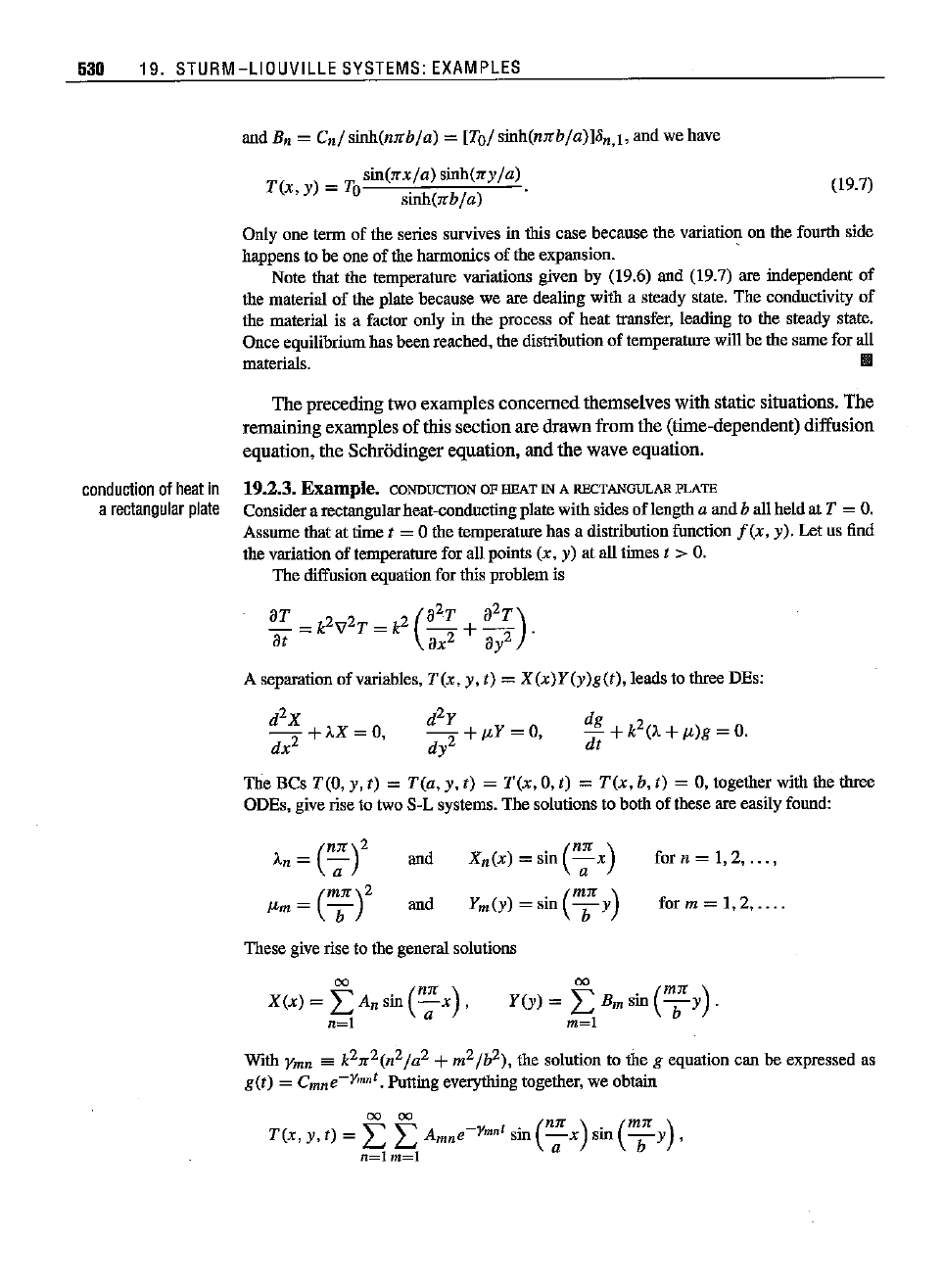
530 19. STURM-LIOUVILLE
SYSTEMS:
EXAMPLES
and B
n
= e
n
/
sinh(mrb/a) = [To/ sinh(mrb/a)]8
n
,"
and we have
T(x
) =
To
sin(rrx/a) sinh(rry/a).
, y 0 sinh(rrb/a)
(19.7)
conduction
01
heal
in
a
rectangular
plate
Onlyone
term
of theseries
survives
in this case becausethe
variation
on the
fourth
side
happens
tohe oneof the
harmonics
of the
expansion.
'
Note that the temperature variations given by (19,6) and (19.7) are independent of
the
material
of theplatebecausewe
are
dealingwith a steady
state.
The
conductivity
of
the material is a factor only in the process
of
heat transfer, leading to the steady state.
Once
equilibrium
hasbeen
reached,
the
distribution
of
temperature
will bethesameforall
materials.
II
The
preceding two examples
concerned
themselves
with
static sitoations.
The
remaining examples
of
this sectionare
drawn
from
the
(time-dependent) diffusion
equation, the
Schrodinger equation,
and
the
wave
equation.
19.2.3.
Example.
CONDUCTION OF HEAT IN A RECTANGULAR PLATE
Considera rectangularbeat-conductingplate with sidesoflengtha andb all heldat T =
O.
Assume
that
attimet = 0 the
temperature
hasa
distribution
function
I(x,
y). Let us
find
the
variation
of
temperature
forallpoints(x, y) atall timest >
O.
Thediffusion
equation
forthis
problem
is
aT
=k
2V2
T =k
2
(a
2;
+ a
2;).
at ax ay
A separationof variables,
T(x,
y, t) =
X(x)Y(y)g(t),
leads to three DEs:
d
2
y
-2
+iLY=O,
dy
The BCs T(O, y, t) =
T(a,
y, r) =
T(x,
0, t) =
T(x,
b, r) = 0, together with the three
ODEs,giveriseto
two S-L systems.Thesolutions tobothof theseare easily
found:
_
(mr)2
An-
-
a
_
(mrr)2
iLm-
b
and
and
Xn(X) =sin
(n;
x)
Ym(y) = siu
err
y)
for n = 1,2,
...
,
form = 1,2,
....
Thesegiveriseto the
general
solutions
00
X(x)
=
~::>n
sin
ex),
n=I
With
Ymn
==
k
2Jr2(n
2/a
2
+m
2/h
2),
the solutionto the g
equation
canbe
expressed
as
g(t)
= Cmne-Ymnt.
Putting
everything
together,
we
obtain
00
00
(nrr)
(mrr)
T(x,
y, t) = E L Amne-Ymnt sin
--;;x
sin
bY
,
n=lm=l
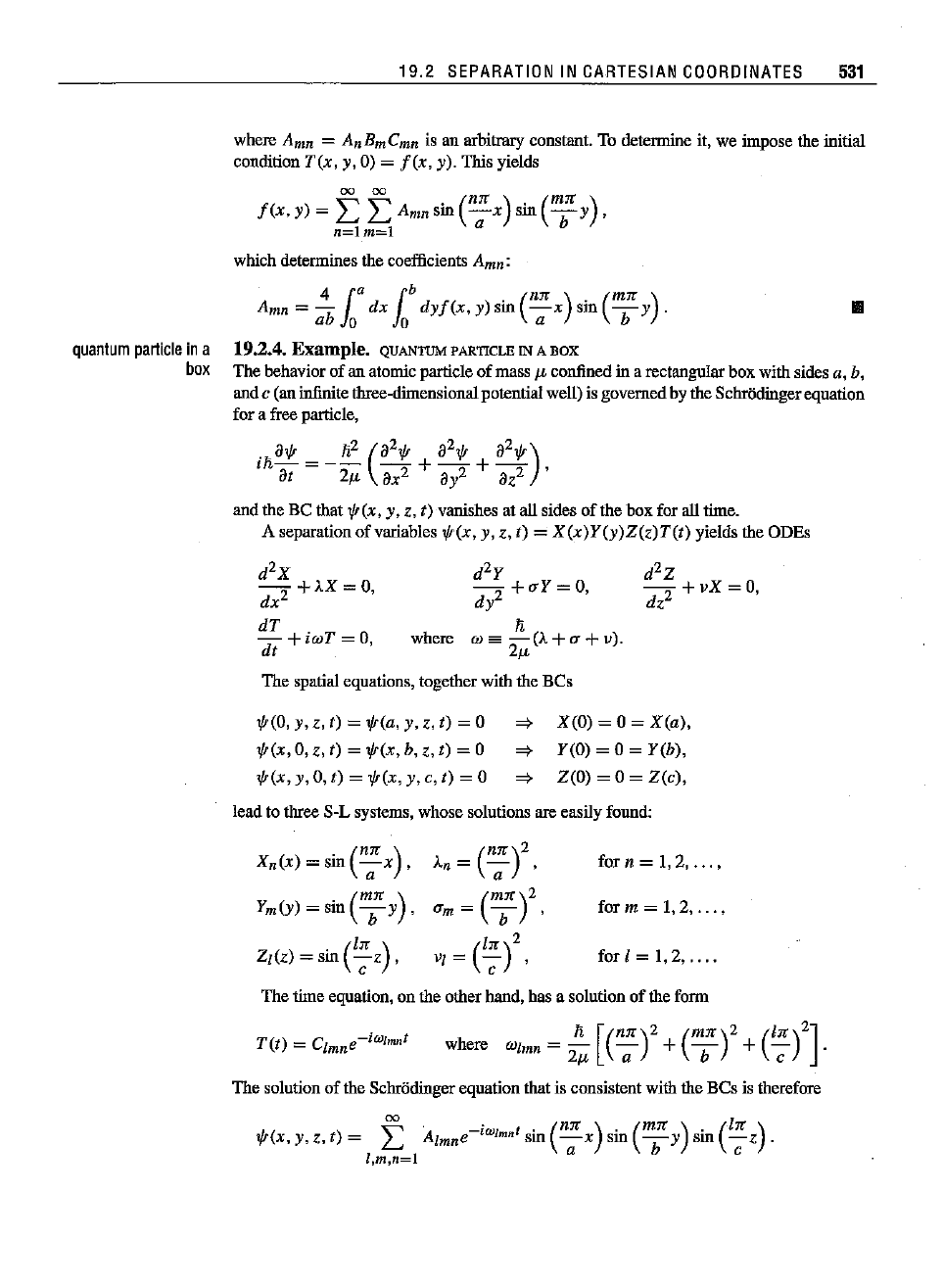
quantum
particle
ina
box
19.2
SEPARATION
IN
CARTESIAN
COOROINATES
531
where
A
mn
= AnBmC
mn
is an
arbitrary
constant.
To
determine
it, we imposetheinitial
condition
T(x,
y, 0) =
f(x,
y). This yields
00 00
f(x,y)
= L L Amn sin
C:
x) sin
C"
y),
n=lm=l
whichdetermines thecoefficientsA
mn
:
A
mn
=
a:
fa"
dx t
dyf(x,
y) sin
C:
x)
sin
C"
y).
..
19.2.4. Example.
QUANTUM
PARTICLEIN A BOX
The
behavior
of an
atomic
particle
of mass
Jl-
confined in a
rectangular
boxwithsidesa, b,
andc (an
infinite
three-dimensional
potential
well) is
governed
bytheSchrodinger
equation
fora free
particle,
ina1/l = _ n
2
(a
2
1/1
+ a
2
1/1
+ a
2
1/1
) ,
at 2/L ax
2
ai
az
2
and the Bethat 1/I(x,y, Z, t) vanishes at all sides
of
the
boxfar
all time.
A separation
of
van
abies
1/1
(x, y, z,t) =
X(x)Y(y)Z(z)T(t)
yields the ODEs
d
2X
-2
+).X=O,
dx
dT
-+iwT=O,
dt
where
d
2
y
-2
+uY=O,
dy
n
ni
ea
-().+u+v).
2/L
d
2Z
-2
+vX=O,
dz
The
spatial
equations, togetherwiththe
Bes
1/1(0,
y,
Z,
t) =
1/I(a,
y,
Z,
t) =0
1/1
(x, 0, z,t) = 1/I(x,b,z,t) = 0
1/1
(x, y, 0, t) = 1/I(x,y, c, t) = 0
=}
X(O) = 0 =
X(a),
=}
YeO)
= 0 = Y(b),
=}
Z(O) = 0 =
Z(c),
leadto threeS-L systems,whose solutionsareeasily
found:
Xn(X) = sin
(n;
x),
Ym(y) = sin
(m
b
"
y),
ZI(Z) = sin e
z),
(
n")2
A
n
= a '
(
m"
)2
U
m
=
b '
VI =
C:)2
for n = 1,2,
...
,
for m = 1,2,
...•
for I =
1,2,
....
Thetime
equation,
onthe
other
hand,
basasolutionof theform
where
Wimn
=
2:
[C)2
+
C")2
+
en·
Thesolution of theSchrodinger
equation
that
is consistent withthe
Bes
is
therefore
1fr(x,
y, Z, r) =
f:
Almne-iWlmnt
sin
(n;
x)
sin
(m
b
7r Y) sin
c:
z).
1,m,n=1
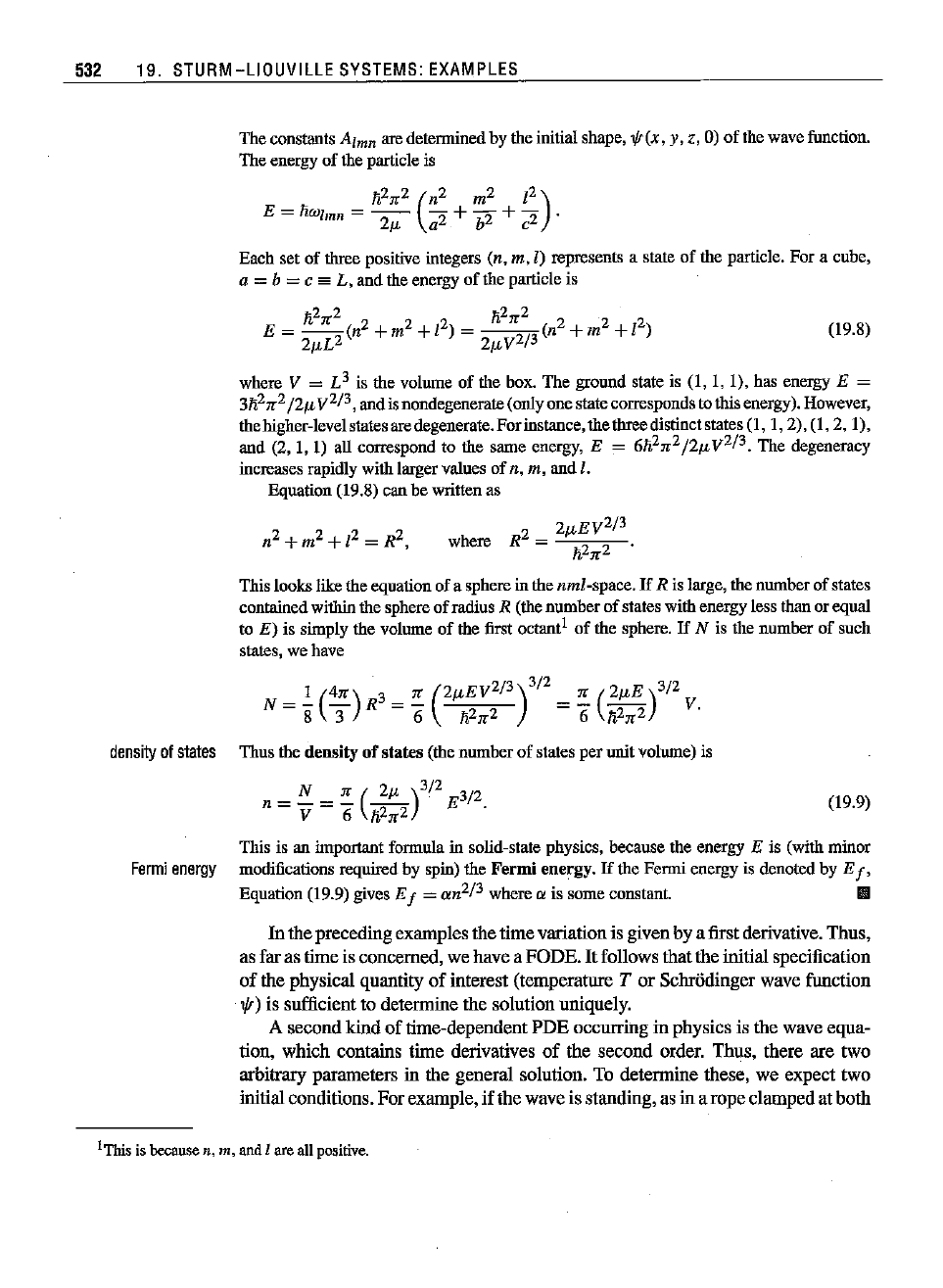
(19.8)
(19.9)
532 19. STURM-LIOUVILLE
SYSTEMS:
EXAMPLES
The constants
Al
mn
are determinedby the initial shape,
1/1
(x,
y, Z, 0)
of
the wave function.
The energy
of
the particle is
/i2,,2
(n
2
m
2
1
2
)
E=nwl
mn
= - -
-2+2+2
.
2/L
abc
Each set
of
three positive integers (n,
m,l)
represents a state
of
the particle. For a cube,
a = b = c
==
L, and the energy
of
the particle is
/i2,,2 /i2,,2
E
=
--2
(n
2
+m
2
+
z2)
= ------Z-/3 (n
2
+m
2
+
z2)
2/LL 2/LY
where V = L
3
is the volume of the box. The ground stale is
(1,1,1),
has energy E =
3lt
2
rr
2
/2f.l-
V
2/3,
andisnondegenerate(onlyonestatecorrespondstothis energy).However,
thehigher-levelstatesaredegenerate. Forinstance,thethreedistinctstates(I, 1,2),(I, 2, I),
and
(2,1,1)
all correspondto the same energy, E =
6/i2,,2/2/Ly
2/3.
The degeneracy
increases rapidly with larger values
ofn,
m, and I.
Equation(19.8)canbe writtenas
2/LEy
2/3
where R
2
= h,2
1r2
This looks like the equation of a sphere in the nml-space.1fR is large, the
number
of
states
containedwithinthe sphere
of
radius R (the
number
of
states with energyless than or equal
to
E)
is simply the volume
of
the first octant!
of
the sphere.
If
N is the
number
of
such
states, we have
density ofstates Thus the
density
of
states
(the
number
of
states
per
unit
volume) is
_ N
_::.
(~)3/2
3/2
n - y - 6 /i2,,2
E.
This is an important formula in solid-state physics, because the energy E is (with minor
Fermi
energy
modifications required by spin) the
Fermi
energy.
If
the Fermi energy is denoted by E
f'
Equation (19.9) gives Ef = an
2j3
where a is some constant.
l1li
In the preceding examples the time variationis given by a first derivative. Thns,
as far as time is concerned, we have a FODE.
It
follows thatthe initial specification
of
the physical quantity
of
interest (temperature T or Schrodinger wave functiou
1/1)
is sufficient to determine the solution uniquely.
A second kind
of
time-dependent
PDE
occurring in physics is the wave equa-
tion, which contains time derivatives
of
the second order. Thus, there are two
arbitrary parameters in the general solution. To determine these, we expect two
initial conditions. For example,if the wave is standing, as in a rope clampedat both
IThis is because n, m, and 1are all positive.
